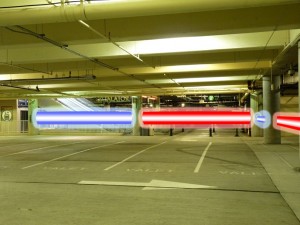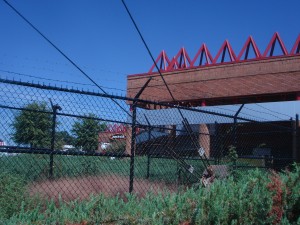BY LAURIE MARION
Upon Rebecca’s recommendation on T-square, I looked at the Non(Place) blog for ideas for digital subversion. The web address for this blog is http://nachbeest.nl/.
This blog has a subtitle, “Using interactive media to add meaning to functional environments.” There is a description of transforming a non-place, such as an airport, into an anthropological place, by making places for tired people (otherwise categorized as “passengers”) to sleep. Airports are designed to move passengers through, to get passengers from one destination to another, to do the opposite of what a real anthropological “place” does. By making sleeping spots, the participants in this project subverted the non-place to create a new meaning within the environment.
The blog mentions two important methodological ideas for this type of activity: strategies and tactics. Below is the text from the blog:
Tactics and strategies (Pierre Bourdieu, sociologist) are very important in our project.
Strategies are planned rules coordinated by a central authority. These rules are meant to influence big groups of people and efficiently guide them to their goals. The rules are universal and are void of all cultural expression.
Tactics are isolated actions made by people in a non-place, that make use of the possibilities that gaps in strategies offer. They are meant to surprise and shock and are used by people to create an autonomous place in a non-place. These tactics are important for us to temporarily transform the airport as non-place into a place.
The key ideas expressed here are that strategies are used by organizations to assert their authority over the individuals who interact with the organizations, and that tactics are ways individuals or groups of individuals can subvert the dehumanizing aspects of the strategies and re-create a sense of anthropological place.
Perhaps for the sake of efficiency, spaces like airports have been designed to minimize or prevent the formation of any feelings of attachment. An airport is not a place to dwell in; it is a space to move through. ” Moving through” is facilitated by signs that indicate the direction one must take to arrive at one’s intended destination. It is rare (perhaps by design) that anything will occur in such a space to which one might attach any special meaning.
The space is designed also to deny that there is any danger involved in traveling. Risk has indeed been minimized so that statistically it is safer to travel by air than by automobile. The denial of danger is also the denial of the possibility of meaning in the space, since meaning is frequently developed by facing and overcoming danger.
Medical offices and hospitals are structured in a way similar to airports in that they have become spaces that are designed to be moved through and not dwelt in. There are triage systems to determine the order in which patients are to be seen, there are time management systems tooptimize a physician’s time, and in hospitals there are protocols to release patients as early as possible after they have been admitted.
This system prevents both medical professionals and patients from developing any emotional attachment to the space or to the process or to the other persons involved. Further, the script especially for “informed consent” to procedures, is designed to downplay if not deny the presence of danger. Again, the overall statistical picture often is that there is less risk of death or permanent damage in undergoing a procedure than there is in letting nature take its course.
In both air travel and medicine, then, there is both a life-and-death situation and a systematic denial of danger.
The group who performed the sleeping experiment in the airport made a point of not moving through the space, but dwelling in it. Sleeping there, allowing it to be part of their dream world, pioneered the kind of emotional attachment that transforms a space into an anthropological place.
What kinds of tactics could be used to transform medical or hospital spaces into anthropological places?
Because a “patient” is usually in pain or experiencing some kind of illness at the time of a visit to a medical office or hospital, his or her ability to execute tactics to make a medical office or hospital into an anthropological place is compromised to a certain extent. How can meaning be generated when one is in this space usually not by choice and there is a chance that the outcome may be a lower quality of life?
One tactic involves making ironic responses to the scripted interactions with personnel. One example that I can give occurred earlier this year when my son was being admitted to the hospital for surgery. The nurse interviewed our family, quizzing us about how did we understand the procedure, what kind of medications would be appropriate post-surgery, what kind of learning style did each of us have – “how do you learn best – are you a visual learner, an auditory learner, a kinesthetic learner, etc.” My husband’s response was that he learns best by yelling. There was probably no tick box on the form the nurse was filling out for this response. A smile and a laugh were generated, a sense of being comrades in arms rather than” institutional representative with all the answers” vs. “powerless individual.”
Another possible tactic to respond to the experience of a nurse filling out forms is to bring forms of one’s own and interview the nurse or any other medical professional in the same way. The forms should be something compiled by a patients’ organization and could include anything that a patient might be concerned about. It could even ask if the doctor performing the procedure has had a good lunch that day, for instance.
This type of query system could be done digitally with iPhones or Droids. Daily updates on patient concerns might make better decisions possible for patients. If you knew, for instance, that a doctor recently stayed up all night, you could decide to opt out of a procedure on that particular day.
If a systematic practice of using this tactic developed, it would then be a strategy itself. The question would still remain how to create meaning in these spaces that are designed to deny its possibility?











